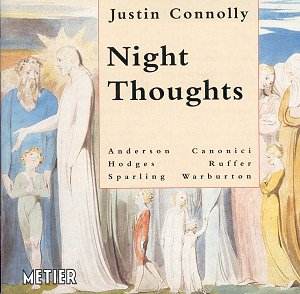I am sad to say that I have heard relatively little
of Justin Connolly’s name in recent years and this new release from
the ever enterprising and commercially fearless Metier label is therefore
most welcome. Furthermore it provides yet greater evidence (as if it
were needed) of David Lefeber’s personal crusade to bring "difficult"
yet rewarding, but above all deserving music to disc.
All of these works are from the last ten or eleven
years although I am not too certain of the reasons for the apparently
wayward designation of the opus numbers. The central thread that runs
through them all is a preoccupation with night and images of darkness.
In the case of the Sonatina No. 2 for piano,
this takes the form, quite literally, of "Night Thoughts",
a poem by Edward Young, later illustrated by William Blake. The composer
explains in his booklet note that he had originally intended to give
the work the same title as the poem until he realised that Aaron Copland
had beaten him to it. Like the poem, the Sonatina is an ennead,
cast in nine parts each of which explores wide ranging yet interrelated
material, the soloist often flitting between sections of technically
complex pyrotechnics to comparative tranquillity. As with all of these
works the language is uncompromisingly atonal although Connolly also
frequently shows that there can be a lyrically expressive side to his
compositional nature.
It is the lyricism of the final two movements that
I enjoyed particularly in Nocturnal, a virtuoso homage to the
late composer and music printer Edward Shipley that effectively comprises
a series of six sea pictures prefaced by a quotation from Melville’s
‘Moby Dick’. Flautist Nancy Ruffer is called upon to play four different
instruments, piccolo, concert flute, alto flute and bass flute, which
Connolly uses in a soloistic role, supported by an ensemble of double
bass, percussion and piano. The composer’s evocative images of the sound
of wind and wave, the creaking of canvas and cordage are equally evocatively
played out in the music, which eventually drifts away on the wind in
the form of a "sea-lullaby".
Tesserae F: Domination of Black (incidentally
the booklet notes frequently confuse here, referring to the work as
‘Domination in Black’ on the outer and inner covers) is a study
in the character of the solo bass clarinet, one of several similarly
titled works for, amongst other instruments, cello and trumpet with
tape. As in Ennead poetry is a source of inspiration, in this
case Wallace Stevens, and again like Ennead Connolly uses the
form of the poem as a means of organising his material, casting the
piece in three "verses". The composer’s common intention with
the poet was to "fill the mind with sounds and images" and
what results is a highly imaginative, technically challenging work that
once again demonstrates Connolly’s gift for musical imagery. [In the
1970s this poem also drew a major orchestral work, sharing the same
title, from Robin Holloway. Ed.]
Connolly describes Scardanelli Dreams as a Cantata
on texts of Friedrich Hölderlin, a cantata in the sense of
the piano providing an obbligato commentary as opposed to an accompaniment,
a function the composer compares with the solo instrumental contributions
in Bach cantatas. What emerges is a complex, rhythmically dense yet
intensely wrought cycle of five Hölderlin settings, set against
a simultaneous cycle of ten sections in the piano which can often move
in unrelated musical directions to the vocal part. The texts themselves
were selected by Connolly for their diversity in reflecting the range
of the poet’s inspiration and it is the contradictions of the texts
that he emulates in the "disassociation" of the piano and
vocal part. It is a toughly challenging work but with an underlying
expressive depth that becomes increasingly manifest upon repeated listening.
Sue Anderson, who commissioned the work and clearly demonstrates an
innate understanding of it, sings with confidence and admirable control.
The playing in all of these works is exemplary although
I would single out pianist Nicholas Hodges, who handles the considerable
technical demands of Connolly’s writing with aplomb and Andrew Sparling’s
fabulous bass clarinet sounds in Domination of Black as particularly
praiseworthy. Indeed, the affinity that Nicholas Hodges has developed
with Connolly’s music has resulted in the commissioning of a Piano Concerto
by the BBC, a work that is in progress at present. One minor gripe.
It would have been very helpful if each of the movements in these works
could have been tracked individually. Not only is a work of over twenty
one minutes and cast in nine sections (Sonatina No. 2) simply
too long not to be tracked, it is also very helpful for the contemporary
music listener to be able to navigate their way around a work as a vital
part of the learning process. Other than this I am simply grateful that
another deserving British compositional talent has eventually had a
long overdue disc devoted to his music.
Christopher Thomas


